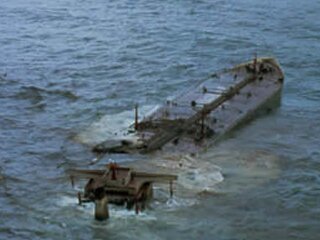AMOCO CADIZ, France, 1978
16 March 1978

Incident
The tanker AMOCO CADIZ ran aground off the coast of Brittany on 16th March 1978 following a steering gear failure. Over a period of two weeks the entire cargo of 223,000 tonnes of light Iranian and Arabian crude oil and 4,000 tonnes of bunker fuel was released into heavy seas. Much of the oil quickly formed a viscous water-in-oil emulsion, increasing the volume of pollutant by up to five times. By the end of April oil and emulsion had contaminated 320km of the Brittany coastline, and had extended as far east as the Channel Islands.
Response
Strong winds and heavy seas prevented an effective offshore recovery operation. All told, less than 3,000 tonnes of dispersants were used. Some chalk was also used as a sinking agent, but with the consequence of transferring part of the problem to the sea bed. The at-sea response did little to reduce shoreline oiling. A wide variety of shore types were affected, including sandy beaches, cobble and shingle shores, rocks, seawalls and jetties, mudflats and saltmarshes. Removal of bulk free oil trapped against the shore using skimmers proved difficult, largely due to problems with seaweed and debris mixed with the oil. Greater success was achieved with vacuum trucks and agricultural vacuum units, although much of the free oil was simply removed by hand by more than 7,000 personnel (mainly military). A considerable portion of the oil that did come ashore eventually became buried in sediments and entrapped in the low energy salt marshes and estuaries.
At the time, the AMOCO CADIZ incident resulted in the largest loss of marine life ever recorded after an oil spill. Two weeks after the accident, millions of dead molluscs, sea urchins and other benthic species washed ashore. Although echinoderm and small crustacean populations almost completely disappeared from some areas, populations of many species had recovered within a year. Diving birds constituted the majority of the nearly 20,000 dead birds that were recovered. Oyster cultivation in the estuaries ("Abers") was seriously affected and an estimated 9,000 tonnes were destroyed because of contamination and to safeguard market confidence. Other shell and fin fisheries as well as seaweed gathering were seriously affected in the short-term, as was tourism.
Cleanup activities on rocky shores, such as pressure-washing, as well as trampling and sediment removal on salt marshes caused biological impacts. Whilst rocky shores recovered relatively quickly, the salt marshes took many years. Failure to remove oil from temporary oil collection pits on some soft sediment shorelines before inundation by the incoming tide also resulted in longer-term contamination.
ITOPF Involvement
ITOPF were present on-site during the response. Numerous clean-up and impact lessons were learned from the AMOCO CADIZ incident, and it still remains one of the most comprehensively studied oil spills in history.
Selected Bibliography
- Bellier, P. and Massart, G. (1979). The Amoco Cadiz oil spill cleanup operations - an overview of the organisation, control and evaluation of the cleanup techniques employed. Proceedings of the 1979 Oil Spill Conference, 141-146. API Publication No. 4308. American Petroleum Institute, Washington, DC, USA
- NOAA (1978). The Amoco Cadiz oil spill: A preliminary scientific report. A National Oceanic and Atmospheric Administration and Environmental Protection Agency special report, Washington DC, USA
- Spooner, M.F. (editor) (1978). The Amoco Cadiz oil spill. Special edition of Marine Pollution Bulletin 9 (7). Pergamon Press, Oxford and New York
- Conan, G., d'Ozouville, L., and Marchand, M. (1978). Amoco Cadiz - preliminary observations of the oil spill impact on the marine environment. One day session, Amoco Cadiz, Brest, France, 7 June 1978. Le Centre National pour l'Exploitation des Oceans, Paris, France
Links
Categories: France, Oil, Oil Tanker, Europe, Environmental effects
